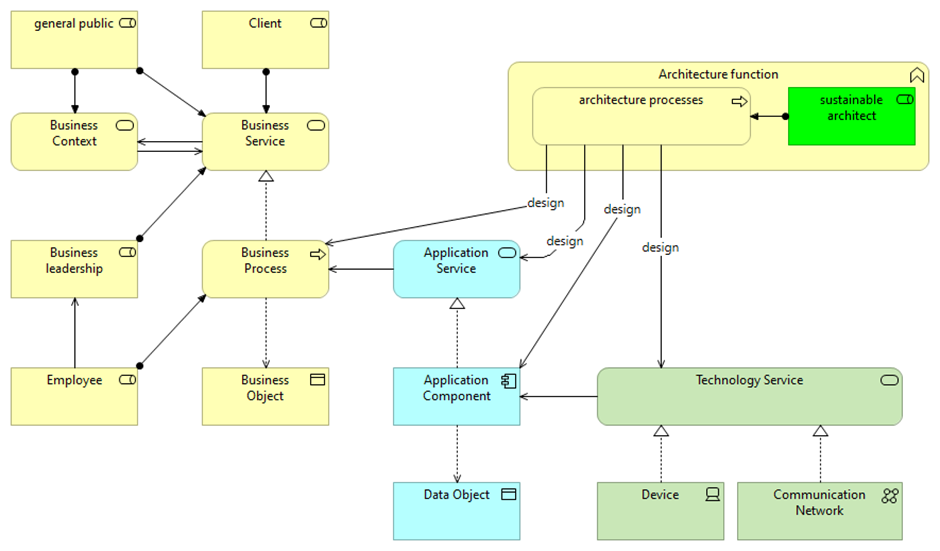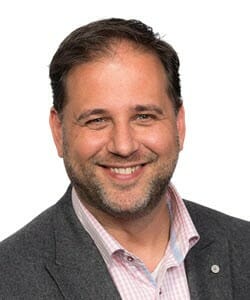As an architect, my greatest value lies in facilitating and supporting the decision-making processes of our business leaders, preferably within a rational and transparent working framework. In this capacity, I am occasionally tasked with crafting visions on various topics. While I possess general knowledge on most subjects and can delve into IT-related matters with research, the concept of sustainability remains elusive even after thoughtful consideration. Allow me to share my approach to researching and comprehending sustainable IT, exploring what it truly means to be a sustainable architect.

Drawing on my role as an architect, I have developed a generic model to organize my thoughts and writings on this subject. I begin with the architectural layers of business, information, application, and technology, employing a function-construction cascade:
- Business service (function) – realized by – business process (construction)
- Business process (construction) – served by – application service (function)
- Application service (function) – realized by – application component (construction)
- Application component (construction) – served by – Technology service (function)
- Technology service (function) – realized by – Devices and communication network (constructions)
Expanding on this cascade, I consider the business context, incorporating stakeholders such as clients, the general public, business leadership, and notably, the employees.
And, of course, let’s not overlook the architects themselves. The architecture function involves designing various elements such as business processes and application services. In this model, I use the simplified term “design” for architecture processes, encompassing tasks such as creating models and architecture principles and supporting decision-making about acquiring, developing, and deploying IT-related investments. This sets the context for being an architect. Now, what about sustainability?
Discovering sustainable
“Sustainable” is a multifaceted term with diverse meanings depending on the context. The broader definitions taken from large language models offer insights:
- In the environmental context, “sustainable” refers to practices, processes, or development that can be maintained over the long term without causing significant harm to the environment. This involves minimizing the use of non-renewable resources, reducing pollution, and promoting biodiversity.
- In the economic context, “sustainable” pertains to activities or strategies that are financially viable over the long term. It involves making choices that support economic growth without depleting resources, creating excessive debt, or causing economic instability.
- In the business context, “sustainable” refers to business practices that consider long-term environmental, social, and economic impacts. Sustainable business models aim to balance profit with responsibility, often incorporating ethical considerations, social responsibility, and environmental stewardship.
- In a lifestyle context, “sustainable living” involves adopting practices that minimize personal ecological impact. This includes reducing waste, using eco-friendly products, and making choices that promote environmental and social responsibility.
- In the technology context, “sustainable technology” encompasses the development and use of technologies that have a minimal impact on the environment, use resources efficiently, and contribute positively to social and economic well-being.
All these explanations underscore the versatility of the term “sustainable” and its applicability across various domains to promote responsible and balanced practices.
Taking a stroll through history, the idea of sustainability began during the inaugural United Nations Conference on the Environment in 1972. However, it found its true form in 1987 with the release of the renowned Brundtland Report, famously titled “Our Common Future.” This 300 page report played a pivotal role in crystallizing the objectives of sustainable development. Notably, the Brundtland Report laid the foundation for what is now commonly referred to as ESG—Environmental, Social, and Governance—comprising the three pillars or principles that underpin sustainability.
My view as professional architect
The explanation that resonates most with me as a professional architect is akin to the business context variation mentioned earlier. For me, the concept of sustainability involves the capacity to endure or resiliently navigate challenges, pressures, or changes without significant degradation or interruption. It underscores continuity and the ability to persist in the face of external disruptions. In a business context, sustainability implies the capability to maintain successful operations over an extended period. This encompasses effective management, adaptability to market changes, and the adoption of responsible business practices that account for long-term impacts.
The distinctions between these explanations appear to revolve around the material and time scope of the effects stemming from business activities.
The first, larger, and long-term scope revolves around preventing impact on the general environment, affecting various categories of stakeholders. The second, smaller, and short-term scope is about my ability to sustain multiple objectives, thus necessitating caution about the available resources required to maintain or endure these objectives, independent of external changes. This entails being resilient.
Resilience on a long-term scale for an enterprise may involve accumulating a substantial quantity of resources in the short term and organizing the continuity of its supply chains. However, this strategy may have enduring consequences for others and the world at large. Striking a balance between these considerations presents both a business and an ethical dilemma, introducing a new dimension to the discussion and opening the can of worms known as business ethics.
Examining employees and their triple role in an organization, they function as employees, members of the general public, and perhaps even customers of the enterprise’s products or services. It’s not uncommon for there to be differences in their interests across these roles. As an employee, there is a desire for the employer to be resilient and stable, ensuring a consistent income—particularly if the employee faces limitations in skills, education, and employment opportunities. As a member of the general public, the expectation is for the enterprise to be eco-friendly, considering both short and long-term environmental impacts. As a customer, the desire is for affordable and durable products. A relatively new addition is the role of the purpose-driven employee, who seeks alignment between the enterprise’s mission and their personal values, with the condition that they won’t engage with an enterprise that doesn’t align with their ethical stance.
This view differs from the Brundtland view which I learned of recently. My view is much more focused on organizing an organization. What is common is the awareness that the concept of sustainability is very multifaceted.
The architecture layers
Indeed, sustainability is a complex matter, and determining the most relevant perspective for architects can be challenging. It may be argued that all perspectives—environmental, employee and operational—are crucial for architects to consider.
In the functional view of the business service, architects influence the general public and clients. This perspective inherently demands a sustainable and affordable product without causing long-term damage to the ecology. Architects establish boundaries for these services with the goal of minimizing environmental impact. The challenge lies in finding a balance between creating a product that meets the needs of users, has minimal ecological impact, and remains economically viable.
The business process, viewed from a construction perspective, is crucial for realizing the demands of stakeholders. This construction utilizes resources such as employees, money, and materials, affecting both short and long-term perspectives. Architects play a role in resource optimization, being frugal with materials and aligning the purposes of involved employees to enhance both efficiency and sustainability.
Moving to the functional view of the application service, architects must enable various business processes. The emphasis is on selecting and ensuring the completeness of these services while preventing unnecessary functionality to control costs. This aligns with the internal endurance perspective, focusing on the efficient use of resources within the organization.
In the construction view of the application component, architects face the challenge of preventing overlap with multiple application constructions for single functions. Striking a balance between creating a single solution to support a business process and allowing room for creative usage is essential for fostering employee freedom and sustaining a dynamic workforce.
Finally, in the functional view of the technology service, architects must ensure the effectiveness of devices and communication networks while being mindful of resource usage, particularly energy. The need for a balanced approach arises, considering both cost-effectiveness and redundancy to sustain application services and business processes in case of failures.
Ultimately, architects face the challenge of navigating these intricate considerations and finding a delicate balance between environmental responsibility, operational efficiency, and the empowerment of employees for long-term sustainability. Initially, I believed that combining the elements in the ArchiMate models would straightforwardly provide the answers. However, it has become apparent that this topic demands further research and discussion. Nonetheless, structuring these thoughts has proven valuable.
Next
In the next blog of this series on architecting sustainability, we will introduce a new motto: Vitality. Following that, we will delve into establishing some fundamental architecture principles. This ongoing exploration aims to contribute to a more comprehensive understanding and practical application of sustainable architectural practices.

 English | EN
English | EN 